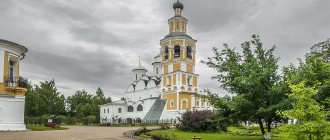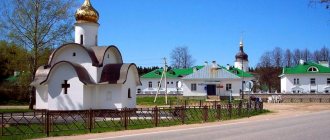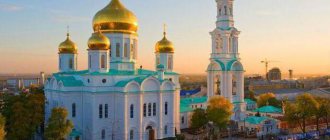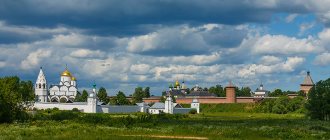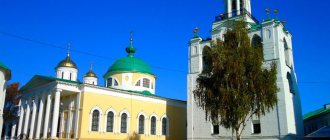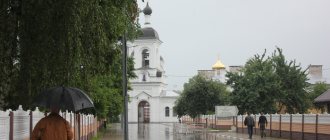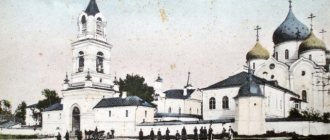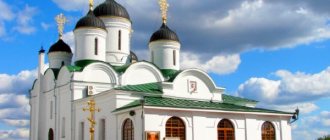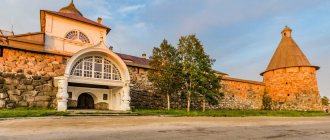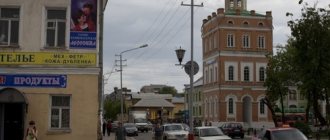The history of the Spaso-Yakovlevsky Dmitriev Monastery began back in 1389, when the Rostov Bishop Jacob fled the city and settled south of Rostov next to the Church of the Archangel Michael, around which a community was subsequently formed, which laid the foundation for the monastery. The bishop was expelled from the city for a reason - former like-minded people were angry with him because he pardoned a criminal who was awaiting execution, and instead of death, sent her to a monastery to repent. Initially, the monastery, founded on the shore of Lake Nero, was named Zachatievsky, in honor of the wooden Church of the Conception of the Blessed Virgin Mary, which the former bishop cut down with his own hands. Three years later, Jacob died, he was buried in the Church of the Conception and began to be revered as a saint (he was officially canonized only 150 years later - at the Makarievsky Council of 1549).
By the way, the relics of Jacob Dmitrovsky are now kept hidden in the Church of the Conception of St. Anna, and it is from there that we will begin our acquaintance with the monastery.
Life of Saint Demetrius
Dmitry was born in 1651, at the age of 16 he became a monk and lived in the Kiev Cyril Monastery until he was 23 years old. Later, he became a clergyman and gained fame as a spiritual preacher, devoting several decades to compiling the lives of the saints of the Orthodox Church - four books of the Chetya-Minea, writing a spiritual alphabet, many dramas and poems.
Dmitry spent the last 7 years of his life (until 1709) in Rostov. He is highly revered by Russian believers for his contribution to the development of education, the fight against ignorance and drunkenness, as well as for his polemics with adherents of the Old Believer faith and Catholicism. 48 years after his burial, Dmitry was canonized. Today the shrine with the relics of St. Dmitry is in the monastery’s Conception Church.
View of the Spaso-Yakovlevsky Dimitriev Monastery from Lake Nero
Story
Spaso-Yakovlevsky Dimitriev Monastery in Rostov the Great. Photo by P. N. Rubtsov
His rapid rise is directly related to the canonization and glorification of Metropolitan Demetrius, who chose this monastery as his burial place.
Saint Demetrius of Rostov. Painting of the altar of the Dimitrievsky Church of the Spaso-Yakovlevsky Monastery. 19th century
Metropolitan Dimitry (1651 - 1709) - head of the Rostov-Yaroslavl diocese, a famous preacher and spiritual writer. A native of the Kyiv land, he ended his life in Rostov. His life was entirely devoted to serving the Church - at the age of 17 he became a monk, was a preacher and abbot of many monasteries, created a grandiose church work - a collection of the lives of saints, and ruled the ancient and noble Rostov bishop's see. He was endowed with an abundance of creative talents - he became famous as a spiritual writer, historian, theologian, and playwright. He left behind a huge literary heritage.
Chetya-Minea of St. Demetrius of Rostov. 19th century edition
Merciful, humble, pure in heart, throughout his entire life he served as a high moral example. The enormous moral message inherent in his creations, primarily in the Four Menaions, earned him fame as an educator of human souls.
Metropolitan Dimitri chose the Yakovlevsky Monastery as the place of his burial, which was confirmed in his will. On October 28, 1709, he died and was buried in the monastery he had chosen.
In September 1752, the relics of Metropolitan Demetrius were found; five years later, in April 1757, he was canonized. The canonization of Metropolitan Demetrius became the first canonization in the history of the Russian Orthodox Church during the synodal period. The Rostov ruler became the first saint of Russia in modern times.
The burial of the bishop in the monastery cathedral and the discovery of his relics, the canonization of the saint and the widest spread of his veneration were the key to the prosperity of the Yakovlevsky monastery. An ordinary, unremarkable provincial monastery overnight turned into one of the most famous monasteries in the country, guarding a great shrine.
Silver shrine of St. Demetrius, made at the direction of Empress Elizabeth Petrovna. It was into this shrine that the relics of the saint were transferred during a visit to the monastery by Catherine II
Many pilgrims flocked here to the miraculous relics of St. Demetrius. Among them were many representatives of the royal family. Thus began a pilgrimage to the Yakovlevsky Monastery of representatives of the Royal House of Romanov.
This tradition was started by Empress Catherine II, who arrived at the Yakovlevsky Monastery in 1763 to celebrate the transfer of the saint’s relics into a silver shrine.
Portrait of Empress Catherine II
After her, in the 19th and early 20th centuries, almost all Russian emperors and many great princes and princesses visited here on pilgrimage. To date, 20 facts of visits to the Spaso-Yakovlevsky Monastery by members of the imperial family have been documented: 6 times by ruling sovereigns and empresses, once by the Dowager Empress, 13 times by grand dukes and princesses. In the period from 1763 to 1916, that is, over 150 years, four emperors, three empresses and more than twenty representatives of the grand ducal family visited here. The monastery was visited twice by Empress Catherine II and Emperor Alexander II, and three times by Grand Duchess Martyr Elizabeth Feodorovna.
Particularly memorable for the monastery was the arrival of Emperor Nicholas II, which occurred on May 22, 1913 and turned out to be the last visit to the monastery by the last Russian emperor.
Almanac published for the 300th anniversary of the House of Romanov. 1913
In 1913, the Russian Empire celebrated the 300th anniversary of the reign of the House of Romanov. As part of the anniversary celebrations, a trip was organized for the imperial family to the Nizhny Novgorod, Kostroma, Yaroslavl and Moscow provinces to visit places associated with the election to the kingdom of the first representative of the new reigning family - Tsar Mikhail Fedorovich. Rostov, the oldest city in the Yaroslavl province, was also included in the route of this trip.
Emperor Nicholas II. Circa 1907
In the diary kept by Emperor Nikolai Alexandrovich, several meager lines are devoted to his impressions of visiting the Rostov shrines. “May 22nd. Wednesday. At 10 o'clock we arrived in Rostov. Alix was very tired and, in addition, she had a sore throat, so she lay there all day. After the meeting, I drove with the children in a car to the ancient city of Rostov the Great. I visited the Assumption Cathedral, listened to the famous ringing of bells, walked along the Kremlin wall to the White Chamber and the Prince's Tower, examining the internal churches along the way. Returning to the train, we stopped at the Church of the Annunciation, where the miraculous icon of the Tenderness of the Mother of God appeared in 1910. After breakfast, I went into the city again and examined the Yakovlevsky Monastery. on the shore of Lake Nero and in 3 ver. the old wooden church of St. John the Evangelist on Ishna. Got back on the train with the kids at 4?. I drank tea and studied. AT 6? I went with my daughters to the Kremlin to the beautiful Church of the Resurrection of Christ for the all-night vigil. We left Rostov at 8 o’clock.”
Rostov Assumption Cathedral. May 22, 1913
However, this day was long-awaited and significant for both the city and the monastery. They prepared for it long and carefully. The objects to be shown were selected in advance. The places where the sovereign would visit were to be the cathedral, the Rostov Kremlin and the exhibitions of the Museum of Church Antiquities, the Spaso-Yakovlevsky Monastery and two churches of the 17th century - the city Church of the Annunciation and the rural Church of St. John the Evangelist in the vicinity of Rostov. The travel route was laid out in advance and the meeting ceremony was developed.
Emperor Nicholas II in the Spaso-Preobrazhensky Monastery. Yaroslavl, May 21, 1913
The emperor’s acquaintance program with Yaroslavl, by the way, was much more eventful, which is not surprising, taking into account the difference in the scale and significance of the cities. In Yaroslavl, the distinguished guests were going to be shown the cathedral, the bishop's house in the Spassky Monastery, the Kazan Monastery and two churches of the 17th century - Elijah the Vice and John the Baptist, about which, by the way, the sovereign said that they were “one more beautiful and better than the other.” The Emperor was expected to get acquainted with an orphanage founded in honor of the 300th anniversary of the Reigning House and a specially organized exhibition, clearly demonstrating the achievements of the province in the field of agriculture, crafts and industry, a trip to the Tolga Monastery and, finally, a visit to a social reception at the noble assembly.
The imperial family was supposed to arrive in Rostov by train heading from Yaroslavl towards Moscow, so the meeting and seeing off of distinguished visitors took place at the Rostov station. Subsequent movements around the city were carried out by car.
The imperial family in the Kazan monastery. Yaroslavl, May 21, 1913
In preparation for the arrival of the emperor, Rostov was transformed, although not all of it, but only that part of it that was going to be shown to the sovereign. The facades of those houses that were located along his route were repaired, cleaned and repainted. Likewise, the repairs affected only those streets along which the imperial cars were supposed to pass, they were leveled and filled with fresh yellow sand. Immediately before arrival, the houses were decorated with flags and garlands woven from green branches.
Rostov Kremlin.
Photo by S. M. Prokudin-Gorsky. 1911
So, a qualitative improvement in both the external appearance of the buildings and the roadways took place only along the route of the imperial motorcade, namely: from the station square along Blagoveshchenskaya Street, further along the boulevard, along the building of the new gymnasium - to the city center, through Emelyanovsky Row and Cathedral Square - to the Holy Gate, leading to the Assumption Cathedral and the former bishop's courtyard. Then across the Kamenny Bridge along the boulevard and Pokrovskaya Street, to its intersection with Rozhdestvenskaya, and along Malaya Yakovlevskaya Street - to the Spaso-Yakovlevsky Monastery, and from there along the Moscow Highway - to the wooden Church of St. John the Theologian in the village of Bogoslov.
Blagoveshchenskaya street in Rostov. May 22, 1913
The Spaso-Yakovlevsky Monastery took the preparations for the imperial visit more seriously and responsibly. Work to improve the external appearance of the monastery began in advance and was carried out on a wide front.
The main attention was paid to decorating the interiors of the old Conception and new Dimitrievsky monastery cathedrals. In the Conception Church, the wall paintings were washed and restored, new frames were installed and the entrance doors were replaced. In the Demetrius Church, a marble platform was installed for the new, second silver shrine of St. Demetrius and marble vestments were made for the thrones of two side churches in the refectory.
The gilding of the large dome and the replacement of the roof of the Conception Church have been completed. The roofs of residential buildings were painted with copper, and the domes of temples were covered with ultramarine paint.
All the monastery buildings were cleaned and whitewashed anew - churches, cell buildings and fences, as well as all the buildings that belonged to the monastery but were located outside its walls - a hotel, a school, several outbuildings.
The paths of the central monastery courtyard were covered with asphalt. A new bell weighing 155 pounds appeared on the bell tower.
Cathedral of Demetrius of Rostov in the Spaso-Yakovlevsky Monastery. Early 20th century
Especially for the royal arrival, they purchased a new sacristy, which included full bishop's vestments for the rector, 10 priestly vestments, 1 archdeacon's vestment, 4 deacon's vestments and 4 sexton's vestments. To emphasize the correspondence with the date being celebrated, the 300th anniversary of the reign of the Romanov dynasty, the new sacristy was deliberately stylized as antique. There is evidence from Bishop Joseph that the monastery clergy greeted the sovereign in new vestments, made in the style of Rostov church clothes of the 17th century.
In general, by the arrival of the emperor, the Spaso-Yakovlevskaya monastery was transformed - the domes shone, the walls turned white, the temples became more beautiful, and the courtyard became cleaner. However, it should be taken into account that even before the start of all the above works, the condition of the monastery was more than satisfactory, since in 1909 it significantly updated its appearance, preparing for the anniversary celebrations in honor of the 200th anniversary of the death of St. Demetrius.
Meeting Emperor Nicholas II at the Rostov railway station
The imperial family arrived in Rostov on May 22, on the eve of the celebration of St. Leontius of Rostov, whose memorial day has long been considered one of the main church holidays in Rostov. Due to ill health, Empress Alexandra Feodorovna was unable or unwilling to take part in the acquaintance with Rostov; upon arriving in the city, she never left her carriage.
Concert of Rostov bells
On the Cathedral Square of Rostov the Great
In the first half of the day, the emperor with his children and a large retinue visited the Assumption Cathedral and the Rostov Kremlin. The sovereign was accompanied by the head of the Yaroslavl diocese, Archbishop Tikhon (Bellavin), the future Russian patriarch, canonized. The emperor examined the cathedral, bowed to its shrines, and examined the antiquities of the sacristy. On Cathedral Square, a concert of bell ringing from the cathedral belfry, performed on huge ancient bells, the heaviest of which weighed 32, 16 and 8 tons, was given especially for the guests.
Museum of Church Antiquities.
Photo by S. M. Prokudin-Gorsky. 1911
Then the emperor was shown the Rostov Kremlin - the former bishop's residence and the Museum of Church Antiquities located within its walls. The Emperor walked along the Kremlin passages, visited ancient temples, climbed the observation tower, and got acquainted with museum exhibitions.
The second half of the day, according to the approved regulations, was devoted to getting to know the Spaso-Yakovlevsky Demetrius Monastery.
Bishop of Uglich Joseph Petrov (1872 - 1937)
The main source of information about how the imperial visit to this monastery took place is the memoirs of its rector, Bishop Joseph (Petrovykh; 1909 - 1926), the first vicar of the Yaroslavl diocese. In the future, we will repeatedly refer to this valuable documentary evidence.
For example, this is how Yakovlev’s abbot described the anticipation of the imperial arrival: “An hour before the sovereign’s arrival, the loud bell of the monastery notified everyone of the approach of a joyful moment. ... The ancient Conception Cathedral, richly decorated with carpets, just washed from top to bottom and consecrated with three chandeliers with candles in wax yarago, looked extremely cozy and festively cheerful. Soon the preparatory bustle subsided everywhere, and sacred silence and awe of anticipation reigned. It became quiet in the temple. Only the candles crackled merrily all around, and the vigilant guard of the monastery belfry hummed in the distance, with each blow announcing the greater and greater proximity of the royal pilgrims.”
Cathedral of the Conception of St. Anna of the Spaso-Yakovlevsky Monastery.
Photo by S. M. Prokudin-Gorsky. 1911
The Spaso-Yakovlevskaya monastery greeted the royal family with the ringing of bells. The imperial car drove into the monastery and stopped at the entrance to the Conception Cathedral, on the steps of which Bishop Joseph met Nicholas II.
At the relics of St. A prayer service was served for Demetrius. Nikolai Alexandrovich paid special attention to the ancient murals of the cathedral. This is not surprising, given that shortly before his arrival in Rostov, he donated three thousand rubles to the Spaso-Yakovlevsky Monastery, specifically intended for washing these frescoes. The emperor was interested in the stone iconostasis and the silver shrine of St. Demetrius.
On the porch of the Conception Church, the royal family stopped at the tomb of Elder Amphilochius, who served as a funeral hieromonk for more than 40 years at the relics of St. Demetrius.
From the Conception Cathedral, the emperor and his children, surrounded by his retinue, went down to the Resurrection Church, located in the basement of the Yakovlevsky Church. Founded a little over a year ago, this church was designed as a kind of reliquary temple containing copies of the main Christian shrines, the main one of which was the likeness of the Holy Sepulcher. It attracted the special attention of the sovereign. As Bishop Joseph wrote: “Despite the very narrow entrance to the cave of the Sepulcher, the entire royal family and the sovereign went up there at the same time and remained there for a long, long time in a tender and prayerful mood. Illuminated by 33 lamps (according to the number of years of Christ) and decorated with flowers, lamps and sacred images, the cave makes a strong impression on the soul, transferring the thought to the authentic places and setting of the death and burial of the Savior.”
Having left the Church of the Resurrection, Emperor Nikolai Alexandrovich and his children went through the Water Gate to the shore of Lake Nero.
Emperor Nicholas II with children in the Spaso-Yakovlevsky Monastery. May 22, 1913
Then the distinguished guests visited Demetrius Cathedral. Its enormous size and unusual interior design, the iconostasis in the form of a large triumphal arch, undoubtedly attracted their attention.
Interior of the Cathedral of St. Demetrius of Rostov.
Photo by S. M. Prokudin-Gorsky. 1911
Here were the relics of the monastery, transferred from the sacristy and put on display for the sovereign, including personal belongings and manuscripts of St. Dimitri. Along with other rarities, the sovereign was shown a small 4-pound bell, called the “royal” bell, donated to the monastery in the mid-17th century by Tsar Alexei Mikhailovich.
Spaso-Yakovlevsky Dimitriev Monastery.
Photo by P. N. Rubtsov
In memory of his visit to the monastery, the emperor was presented with icons, enamel portraits, photographs and books. After visiting the Dimitrievsky Church, the royal family left the monastery to the sound of bells.
Church of St. John the Evangelist on the Ishna River.
Photo by S. M. Prokudin-Gorsky. 1911
The demonstration of Rostov attractions ended with a visit to the wooden Church of St. John the Evangelist on the Ishna River. The temple, built at the end of the 17th century, has preserved both the interior and the atmosphere of an ancient monument.
Resurrection Church of the Rostov Kremlin.
Photo by S. M. Prokudin-Gorsky. 1911
After a short rest on the train in the evening, the emperor returned to the Rostov Kremlin in order to attend the festive all-night vigil on the eve of the Feast of the Ascension of the Lord, which was served especially for him in the Resurrection Church, which he especially liked. This temple, decorated with first-class fresco paintings, is indeed extremely beautiful; its unique decoration embodies the spirit of antiquity.
At eight o'clock the royal train left Rostov, continuing its journey to Moscow.
Imperial family. 1913
Let's summarize some results. As is known, the journey of the imperial family to places associated with the calling of the founder of the dynasty to the kingdom and made in memory of the 300th anniversary of this event had a clear historical orientation. It was a kind of immersion in the past, an attempt to join or at least get closer to the times of the reign of the dynasty, to the era of the first Romanovs. It is no coincidence that in both Rostov and Yaroslavl the sovereign was shown churches of the 17th century.
As for the Spaso-Yakovlevsky Monastery, it was difficult for it to fully correspond to this historicity, since its heyday, its shrines and attractions belonged to the new era. However, here he did not stand aside - the sovereign was met by the brethren, dressed in new clothes made in the ancient style, the emperor was shown the ancient paintings of the old cathedral, washed and renewed specially for this purpose. We can say that in demonstrating itself, the monastery relied on its main shrines, as well as royal and imperial contributions, such as a silver shrine, a royal bell and more.
Memo in honor of the 300th anniversary of the House of Romanov. 1913
Spaso-Yakovlevsky became the only Rostov monastery chosen for a visit by Emperor Nicholas II. The monastery was carefully prepared for this event. Renovating all the facades, gilding the dome, repairing and painting the roofs, washing the murals in the old cathedral, and laying the paths required a lot of time and significant funds. All the preparatory work was organized by Bishop Joseph, he also met the distinguished guests and accompanied them while visiting the monastery sights, which, judging by the testimony of the abbot, made a proper impression on the emperor, especially the new Church of the Resurrection and a copy of the Holy Sepulcher - the pride of Bishop Joseph.
It is important to emphasize that from the second half of the 18th century, the Spaso-Yakovlevsky Monastery was visited by members of the imperial family more often than the Assumption Cathedral and other ancient monasteries of the city. In general, this indicates a shift in value orientations from ancient shrines to new relics, the focus of which in Rostov and, more broadly, in the Yaroslavl diocese was the Spaso-Yakovlevsky Dimitriev Monastery, which assumed the functions of the new spiritual center of both Rostov and the entire diocese.
Spaso-Yakovlevsky Dimitriev Monastery.
Photo by P. N. Rubtsov
In conclusion, let us cite one interesting chronological coincidence. As already mentioned, the first imperial visit to the Yakovlevsky Monastery was the arrival here of Empress Catherine II, the last was the arrival of Emperor Nicholas II. Exactly 150 years passed between these events, almost to the day...
*
Today, as in past times, the Spaso-Yakovlevsky Demetrius Monastery is the main center of veneration of St. Demetrius of Rostov. This is confirmed by the project “Educational mobile exhibition “The Life, Works and Times of Metropolitan Demetrius of Rostov”[1], which in 2021 is being carried out by the Spaso-Yakovlevsky Monastery with the aim of attracting the attention of our contemporaries to the personality and heritage of St. Demetrius - the “new and great wonderworker” , as it is sung in the akathist dedicated to him.
Poster for the site “St. Demetrius of Rostov: life, works, era”
The components of this large project are a bright, interesting exhibition, which was successfully demonstrated during May - November of this year in different cities of the Yaroslavl region, as well as a new beautiful informative website about St. Demetrius (www.dimitryrostovsky.ru), which for the first time summarizes extensive material about the Rostov saint (there are more than 500 publications on the site) - the heavenly patron of the Spaso-Yakovlevsky Demetrius Monastery.
[1] The project is being implemented using a grant from the President of the Russian Federation for the development of civil society, provided by the Presidential Grants Fund, in accordance with the order of the President of the Russian Federation dated April 3, 2021 No. 93-rp.
Author
VIDENEEVA ALLA
Share
Comment
History of the Spaso-Yakovlevsky Dimitrievsky Monastery
On the shore of the lake, where the complex of the modern monastery rises, from the middle of the 13th century there were temples of the convent. Its founder is considered to be Maria, who was the daughter of Prince Mikhail. She was married to the Rostov prince Vasilko Konstantinovich. In 1238, a terrible tragedy entered Mary's life. The princess lost her husband, who died during the battle with the Tatars on the Sit River. Having become a widow, Maria lived in the new Spaso-Pesotsk monastery until her death, and shortly before her death she took monastic vows as a nun. In honor of her, the monastery was called Knyaginin for a long time. Today, the preserved Church of the Savior on the Sands serves as a reminder of the ancient convent.
The history of the men's monastery begins 150 years later than the women's monastery - in 1389.
They began to build it next to the Princess’s monastery, thanks to the decision of the bishop of the Rostov diocese, St. James. Initially, the new monastery was called Zachatievsky, and after the death of Jacob the monastery began to be called by his name.
View of the Spaso-Yakovlevsky Dimitriev Monastery from Lake Nero in winter
Over time, the churches on both monastic territories fell into disrepair. In the 60s of the 18th century, the richer convent was abolished by decree of Empress Catherine II, and its lands and buildings were given to the men's monastery. A fresh breath of monastic life came with Metropolitan Jonah, who became famous for the construction of the stone Rostov Kremlin. In the late 80s - early 90s of the 17th century, the Metropolitan invested in the construction of a brick church over the burial place of St. James and built the old Conception Church in stone. At this time, the monastery itself began to be listed as the Bishop's House in Rostov, and this saved the monastery from ruin.
In the early 1700s, Saint Demetrius settled within the monastery walls, fulfilling the duties of a metropolitan in the Rostov diocese. He lived here for the last seven years of his life and was buried in the Conception Church. To store his relics, Empress Elizaveta Petrovna ordered a beautiful reliquary made from Kolyvanovo silver. But the death of the empress prevented the gifts from being transferred to the monastery. Therefore, in 1763, at the celebrations dedicated to the laying of the relics of St. Demetrius in the shrine, the new queen, Catherine II, was present.
From left to right: Demetrius Cathedral, Yakovlevskaya Church, Conception Cathedral
In the second half of the 18th century, many stone buildings arose on the monastery territory, which replaced dilapidated wooden buildings - a fence with corner and gate towers, a new temple and bell tower, as well as various buildings for the brethren and household needs. A little later, a huge temple was built in the monastery, consecrated in honor of Dmitry of Rostov.
After the stone Church of St. James was rebuilt on the territory of the monastery in the 30s of the 19th century, the monastery took on the appearance we know today.
It grew into a complete architectural ensemble that delighted everyone who visited the ancient Russian city with its massiveness and grandeur.
From left to right: Northern Gate, Demetrius Cathedral
With the advent of the new Soviet period in Russian history in 1923, the monastery was closed. And after 5 years it was forbidden to hold services in all its churches. The premises of the fraternal cells were transferred to a kindergarten, apartments, a military base and warehouses. During these years, the monastery lost almost all of its valuable utensils. Only in 1991 was the monastery returned to believers, and it took several years for its restoration and restoration.
Church of Jacob of Rostov
In 1725, a chapel was added to the Trinity Cathedral of the Conception Monastery, which a hundred years later was dismantled and an independent temple was erected in its place, which was called the Church of Jacob of Rostov. The church was built with the blessing and under the strict guidance of Archimandrite Innocent and was completed in 1836. Countess Orlova, a close friend of Empress Catherine II, donated money for the construction of the temple. Anna Alekseevna Orlova-Chesmenskaya, after the death of her father, became the owner of a multimillion-dollar fortune, and somehow it so happened that at the same time she felt a craving for spiritual life, communicated a lot with her spiritual father, Archimandrite Photius, and donated a lot of money to monasteries. The Spaso-Yakovlevsky Monastery became the first monastery where the rich countess sent her funds, and later a lot of money was sent to the Yuriev Monastery in the Novgorod region.
Church of Jacob of Rostov
The Church of Jacob of Rostov is closely attached to the Conception Cathedral and many even think that this is one temple, but this is not so. The Yakovlevskaya Church was considered warm and, unlike other monastery churches, was heated all year round.
Yakovlevskaya Church
On the left is the Church of St. James, on the right is the Church of the Conception of St. Anne
We jumped ahead a little and from 1725 we immediately found ourselves in the middle of the 19th century, when the construction of the Yakovlevsky Church was completed, which was quite frivolous, because during these hundred years a lot of significant things happened in the life of the monastery. In 1752, during the renovation of the floor in the Trinity Cathedral, the relics of Dmitry of Rostov were discovered, and in 1757 he was canonized.
Almost immediately the number of pilgrims to the monastery increased, and a book was opened in which people recorded the healings that happened to them after venerating the relics of the saint. Over 11 years (1753-1764), 288 entries appeared in it, and this book can still be seen if you go to the archives of the Rostov Museum. In 1764, by order of Catherine the Second, the Spaso-Yakovlevsky Monastery received the highest rank of stauropegial and began to report directly to the Holy Synod.
View of the Yakovlevsky monastery churches from the monastery wall
At the same time, buildings related to the Spaso-Pesotsky Monastery were assigned to the monastery, including the Transfiguration Cathedral, which has survived to this day, and the monastery of the Savior on the Sands itself was abolished. Presumably the stone Church of the Transfiguration was built in 1600, and the monastery itself began its history back in the 13th century.
The wall of the Yakovlevsky Monastery and the Church of the Transfiguration
Transfiguration Cathedral
In the 18th century, the monastery continued to be built and developed: the wooden walls were replaced with stone ones, a bell tower appeared above the eastern gate, and the image of the fortress was complemented by towers that were placed in the corners.
Stone fence of the Spaso-Yakovlevsky Monastery
Openwork fence towers
Tower on the wall of the Yakovlevsky Monastery
Bell tower over the eastern entrance
Bell tower of the monastery
Monastery towers
Architectural monuments on the territory of the Spaso-Yakovlevsky Dimitrievsky Monastery
The very first monastery buildings were wooden and have not survived. The cathedral, consecrated in honor of the Conception of Righteous Anna, was erected in 5 years from 1685 to 1691. This church has no basement. In monasteries, unlike parish churches, there was no need for a basement that served as a warehouse. Initially, the cathedral was covered with a roof, but over time a more practical hipped roof was made for it.
Conception Cathedral
The temple has five domes. Its central golden head is mounted on a powerful light drum, while the remaining blue heads decorated with gold stars rest on smaller, blind drums. This combination of colors in Christian traditions is associated with the name of the Mother of God. Surprisingly, the cathedral has preserved old wall paintings made immediately after its construction, made by famous Yaroslavl painters.
In the 60s of the 18th century, craftsmen from Ostashkov carved a magnificent wooden gilded iconostasis for the temple. Almost two decades later, icons were painted for him by the artist Venedikt Vendersky, who worked at the court.
Demetrius Cathedral
The huge Dmitrievsky Cathedral was built in the traditions of classicism at the end of the 18th - beginning of the 19th century with funds allocated by Count Nikolai Petrovich Sheremetyev.
The cathedral is crowned with a small dome on a large dome. It is decorated on all sides with large porticoes with columns and bas-reliefs. And the painting of the walls inside the cathedral belongs to the brush of the famous Yaroslavl isographer Porfiry Ryabov. Yakovlevskaya Church was rebuilt many times. The last time this happened was in the 19th century, when the temple was dismantled almost to the ground and rebuilt. The architects tried to give its proportions and external decoration a resemblance to the larger Demetrius Cathedral.
To the east of the monastery churches there is a large three-tier bell tower, which appeared here in the 70s of the 18th century. This is the tallest building of the monastery, decorated very strictly and organically fitting into the architectural ensemble of the monastery. The brick buildings of the superior and fraternal buildings, as well as outbuildings, were erected in the traditions of classicism in the last third of the 18th century.
North Gate
Church of the Conception of St. Anna in Rostov the Great
Until the middle of the 17th century, all the buildings of the Spaso-Yakovlevsky Monastery (then Zachatyevsky) were wooden, and none of them have survived to this day. The first stone building was the Conception Cathedral (called Trinity Cathedral until 1754), built in 1686. It was built on the site of the very wooden church that the founder of the monastery, Bishop Jacob of Rostov, erected with his own hands.
Church of the Conception of St. Anne (under the golden and blue domes)
The church preserves ancient frescoes made by Yaroslavl masters. Historians and researchers have documentary evidence that they were made in 1689.
Domes of the Conception Cathedral
The heyday of the Yakovlevsky Monastery occurred at the beginning of the 18th century, when it came under the patronage of Dmitry of Rostov. According to legends, on the very first day (March 1, 1702) he served a prayer service in the Conception Monastery, and then pointed to a place in the southwestern part of the temple and said that he should be buried here.
Current state and mode of visiting Spaso-Yakovlevsky Dimitrievsky Monastery
Today, a brethren of 15 people lives on the territory of the monastery. The monastery devotes a lot of time and effort to research and publishing activities - holding international conferences and seminars, publishing books on the history of Rostov, the monastery and the life of St. Dmitry. It has its own library, sacristy, icon painting and production workshops, a School of Arts and Music, and a Sunday school. In addition, local restoration and renovation of buildings is constantly carried out on the territory.
To support the monastery's economy, there is a bakery, a laundry, a prosphora room, a bathhouse, and work is also carried out in its own vegetable gardens, hay meadows and barnyard. For everyone, the monastery sells delicious home-baked bread, which looks like a tall Easter cake.
From left to right: South (Water) Gate, Southeast Tower
Anyone can enter the monastery territory freely on any day, both pilgrims and tourists. Amateur photography and video shooting is allowed here for free. Excursions are available for organized groups.
Tourists can visit one of the towers of the monastery walls, which offers magnificent views of the lake, temples and the entire monastery complex.
A walk around the monastery is very pleasant. Its territory is paved with neat paths. Inside the monastery walls there is its own young apple orchard, as well as beautifully decorated flower beds, lawns and alleys of berries and ornamental shrubs. In the center, above the source, a wooden chapel was built.
Chapel of Jacob of Rostov over the Holy Spring
Morning services in the monastery churches are held on weekdays at 7.30, and on weekends and holidays - at 9.00. Evening services – daily at 17.30.
Dmitrovsky Cathedral Monastery
At the end of the 18th - beginning of the 19th century, another temple was built in the monastery - Dmitrovsky. Funds for its construction were given by the famous philanthropist and art lover Nikolai Petrovich Sheremetyev - the same one who founded the Hospital for Hospice (Sheremetyevskaya Hospital), today known as the Sklifosovsky Institute of Emergency Care. Dmitrovskaya Church turned out to be the most beautiful and richest on the territory of the monastery, because Sheremetyev sought to build a temple that would be worthy of having the relics of Dmitry of Rostov transferred to it.
Dmitrovsky Cathedral of the Spaso-Yakovlevsky Monastery
But the church authorities took into account the wishes of Dmitry of Rostov himself, who long before his death pointed to the place of his burial, and left the relics in the Conception Church. In memory of the philanthropist, Dmitrovsky Cathedral is often called Sheremetyevsky.
Sheremetyevsky Cathedral
All three churches of the Spaso-Yakovlevsky Monastery form a beautiful ensemble, which looks best from the wall - all three churches lie in full view.
Ensemble of churches of the Spaso-Yakovlevsky Monastery
We have already mentioned that the monastery did not receive its modern name right away: until 1836 it was called Zachatievsky, and only after it was given the status of stauropegial, it began to be called the Spaso-Iakovlevsky Dimitrievsky Monastery. At different times, many famous Russian figures visited the monastery. In addition to all kinds of princes and counts, there were also persons of royal blood: Catherine the Second, Peter the Great, Nicholas the First and Nicholas the Second, Alexander the Second.
The high status of the monastery did not prevent the Soviet authorities from abolishing the monastery; in 1923, the monastery was finally closed, and apartments were located in its buildings. Only after the collapse of the Soviet Union was the monastery returned to believers: by the decision of His Holiness on May 7, 1991, the monastery was revived. Since then, the monastery has gradually gained strength, the number of pilgrims is growing from year to year, tourists love the Spaso-Yakovlevsky Monastery - where else can you find such photogenic buildings that are not covered by modern buildings.
Territory of the Spaso-Yakovlevsky Monastery
Lake Nero near the walls of the monastery
Personally, we like the Spaso-Yakovlevsky Monastery much more than the Rostov Kremlin, so every time we find ourselves in this small town, part of the famous Golden Ring route , we definitely come to its walls.
This article was stolen from the site...
How to get to the Spaso-Yakovlevsky Dimitrievsky Monastery
The monastery is located in Rostov the Great on the shore of Lake Nero at the address: Engels Street, 44.
By car. The federal highway M8, connecting Moscow and Arkhangelsk, leads to Rostov. From the capital to the city - 220 km, and from Yaroslavl - 55 km. Having reached the railway station, you need to turn towards the city center. From here, following Lunacharsky Street, go to the Rostov Kremlin. And from the Kremlin - move along the street. Lenin to the intersection with the street. Moskovskaya, where turn left to Lake Nero. Soon a panorama of the monastery walls opens.
From left to right: Rectory building, Refectory building, Cell building
On your own by train and bus. It is convenient to get from the capital to Rostov on Yaroslavl express trains. They depart twice a day - at 8.20 and at 16.20. The train takes about three hours to Rostov. From the center of Rostov you can get to the monastery by regular buses or minibuses.
Attraction rating
Rating 4.14 [7 vote(s)]
Abbots, governors
- Paul (1623 - 1624)
- Joachim (1686)
- Nicodemus (March 1703)
- Jacob (1720 - 1734)
- Joseph (1734)
- Raphael (1735)
- Bogolep (1736)
- Parmen (1737 - 1740)
- Savvaty (1740 - 1750)
- Serapion (1750 - 1753)
- Gabriel (1753)
- Cyprian (1754 - 1757)
- Hilarion (Zavalevich) (1757 - 1761) May 14, 1758 - to Spassky Yaroslavl. He also ruled the Yakovlevsky Monastery.
- Luke (1761 - September 30, 1763)
- Paul (September 30, 1763 - March 1764)
- Jerome (1764 - 1765)
- Paul (March 26, 1765 - March 1-17, 1769)
- Iriney (Bratanovsky) (August 4, 1770 - April 26, 1775)
- Feoktist (Mochulsky) (July 16, 1775 - 1775)
- Amfilohiy (Leontovich) (1776 - 1787)
- Abraham (Florinsky) (February 9, 1786 - April 30, 1797)
- Melchizedek (Short) (June 14, 1797 - April 1806)
- Apollinary (Pulyashkin) (April 9, 1806 - 1818)
- Dosifey (Nemchinov) (1818 - 1819) acting [2]
…
From 1923 to 1991 the monastery was closed
- Evstafiy (Evdokimov) (May 16, 1991 - January 27, 2000)
- Dimitry (Burov) (2000 - 2003)
- Seraphim (Simonov) (May 7, 2003 - (October 8) October 10, 2009)
- Savva (Mikheev) (October 8 - 10, 2009) acting
- Augustin (Nevodnichek) (March 23 - May 30, 2011) acting
